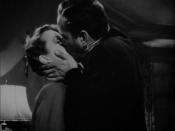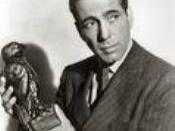One of the most influential film movements in the 1940's was a genre that is known today as film noir. French film critics who noticed the trend of how dark and black films appeared coined the term "film noir." The criminal, violence or greed elements in film noir were a metaphoric symptom of society's evils, with a strong undercurrent of moral conflict. It is a style of American films that first evolved in the 1940s, became prominent in the post-war era, and lasted in a classic period until about 1960. Film noir often tackled subjects that dealt with common underlying themes: corruption, deceit, mystery, etc (Sobchack, 271). One of the most well known and acclaimed pioneers in film noir is John Huston' movie, The Maltese Falcon. One of the first detective films to use the shadowy, nihilistic noir style in a definitive way was the pivotal work of novice director John Huston in the mystery classic The Maltese Falcon.
It was famous for Humphrey Bogart's cool, laconic private eye hero Sam Spade in pursuit of crooks greedy for a jewel-encrusted statue, and Mary Astor as the femme fatale.
Film noir is a French word which means: dark or black film. This is very fitting as film noir and The Maltese Falcon are stories of dark deceptive people who often cannot be trusted. The Maltese Falcon stars Humphrey Bogart in one of his numerous film noir appearances. Playing private eye Sam Spade, Bogart meets up with Brigid O'Shaugnessy, played by Mary Astor. Soon after being hired by O'Shaugnessy, Spade's partner is murdered. As he tries to find out who murdered his partner while helping O'Shaugnessy, Spade becomes involved in a strange mystery surrounding O'Shaugnessy. She turns out to be mixed up with a rough group of people searching for a...

